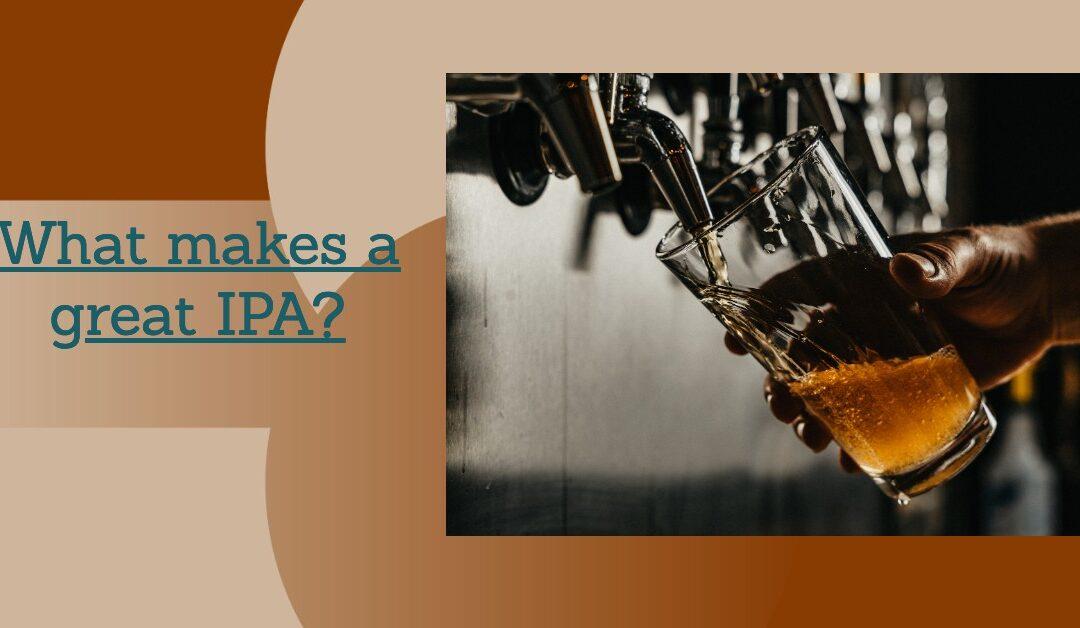A great India Pale Ale (IPA) is characterized by a combination of factors that contribute to its distinct flavor profile, aroma, and overall appeal. These factors include:
- Hop Flavor and Aroma: IPAs are known for their pronounced hop character. The choice of hops, their quantity, and the timing of their addition during the brewing process all play a significant role in determining the hop flavor and aroma. Citrus, pine, floral, and tropical fruit notes are common in hoppy IPAs.
- Bitterness: IPAs often have a notable bitterness, which comes from the hops. The bitterness level is measured in International Bitterness Units (IBUs), and a great IPA typically strikes a balance between hop bitterness and malt sweetness. It’s important that the bitterness doesn’t overpower the other flavors.
- Malt Profile: While hops take the spotlight in IPAs, the malt profile provides the beer’s backbone. A great IPA will have a well-balanced malt sweetness that complements the hop character. This balance ensures that the beer is not overly sweet or excessively dry.
- Alcohol Content: IPAs can vary in alcohol content, but they are generally stronger than many other beer styles. A typical IPA falls in the range of 5.5% to 7.5% alcohol by volume (ABV). The alcohol content should be well-integrated and not overwhelming.
- Clarity and Color: The appearance of an IPA is often characterized by a clear or slightly hazy appearance. The color can range from pale gold to amber, depending on the specific substyle. Clarity and color should be consistent with the style.
- Carbonation: Carbonation levels in an IPA should be moderate to high, contributing to a crisp and refreshing quality.
- Balance: A great IPA achieves a harmonious balance between its different elements. The hops, malt, bitterness, and alcohol should work together to create a complex, enjoyable drinking experience.
- Freshness: IPAs are best enjoyed fresh, as the hop character tends to diminish over time. Brewers often specify the “best by” or “bottled on” date to help consumers choose a fresh product.
- Substyles: There are various substyles of IPAs, such as West Coast IPA, New England IPA (NEIPA), Double IPA (DIPA), and more. Each substyle may have its own unique characteristics and flavor profiles. A great IPA should embody the defining traits of its specific substyle.
- Innovation: Many craft brewers experiment with different hops, malts, and brewing techniques to create unique and innovative IPAs. Some of the most highly regarded IPAs have pushed the boundaries of what’s possible within the style.
Ultimately, the definition of a “great” IPA can be somewhat subjective, as individual preferences for hop intensity, malt sweetness, and other characteristics vary. It’s important to explore different IPAs to find the ones that align with your personal taste preferences. Whether you prefer a classic West Coast IPA with a piney bitterness or a hazy, juicy NEIPA bursting with tropical fruit flavors, the world of IPAs offers a wide range of options for beer enthusiasts to enjoy.
What are some common hops used in an American IPA?
- Cascade: Cascade hops are often credited with helping to define the American craft beer movement. They impart floral, citrus, and grapefruit notes to beers. Cascade hops are versatile and are frequently used in both bittering and aroma additions.
- Centennial: Centennial hops are known for their zesty citrus aroma and floral character. They contribute a balanced bitterness to American IPAs and are often used alongside Cascade hops.
- Simcoe: Simcoe hops offer a complex blend of pine, earthy, and citrusy notes. They are used for both aroma and bittering, and they can add a unique depth to the hop profile of IPAs.
- Citra: Citra hops have gained popularity for their intense citrus and tropical fruit flavors, such as grapefruit, lime, and passion fruit. They are commonly used in late hop additions and dry hopping to maximize their aromatic impact.
- Amarillo: Amarillo hops bring a mix of floral, tropical, and citrus flavors with a distinct orange character. They are often used for aroma and dry hopping.
- Mosaic: Mosaic hops are prized for their complex profile, featuring berry, tropical fruit, citrus, and pine notes. They are frequently used for aroma and dry hopping to showcase their unique characteristics.
- Columbus/Tomahawk/Zeus (CTZ): These three hop varieties, often grouped together as CTZ, are known for their high alpha acid content, which makes them suitable for bittering. They can also contribute some resinous and earthy notes to the flavor and aroma.
- Chinook: Chinook hops have a distinctive piney, spicy, and grapefruit character. They are used for both bittering and aroma, adding a robust hop presence to the beer.
- Amarillo: Amarillo hops contribute orange-citrus, floral, and tropical fruit notes. They are typically used for aroma and dry hopping to enhance the hoppy aroma.
- El Dorado: El Dorado hops are prized for their bold, fruity flavors, which often include watermelon, pear, and stone fruit notes. They are used for aroma and flavor contributions.
- Galaxy: Galaxy hops, originally from Australia, have become popular in American IPAs for their intense tropical fruit, citrus, and passion fruit characteristics. They are primarily used in late additions and dry hopping.
- Idaho 7: Idaho 7 hops are known for their tropical fruit, citrus, and piney qualities. They have gained recognition for their role in the development of juicy and hazy IPAs.
Brewers often use combinations of these hops to create unique flavor profiles in American IPAs. The choice of hops and the timing of their addition during the brewing process allow brewers to experiment with a wide range of flavors and aromas, resulting in the diverse and ever-evolving world of American IPAs.

